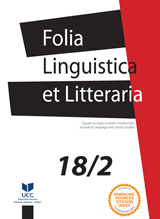KRITIK IM POLITISCHEN DIALOG. EINE SPRECHAKTTHEORETISCHE ANALYSE DER
TYPISCHEN VORWURF-RECHTFERTIGUNG-SEQUENZ AM BEISPIEL EINES FERNSEHINTERVIEWS
CRITICISM IN POLITICAL DIALOGUE AN ANALYSIS OF A TYPICAL REPROACH-JUSTIFICATION SEQUENCE BASED ON SPEECH ACT THEORY: EXEMPLIFIED BY A TELEVISION INTERVIEW
Author(s): Vladimir KarabalićSubject(s): Media studies, Politics and communication, Evaluation research
Published by: Filološki fakultet, Nikšić
Keywords: political dialogue; dialogue pattern; pattern realisation; criticism; reproach-justification sequence; speech act theory; communicative competence; television interview;
Summary/Abstract: In addition to the communication skill of presenting their intentions and acts to the audience in the best possible light and competing for support, in order to be successful, politicians must also possess the ability to selectively criticize and negatively reinterpret the intentions and acts of their political opponent. They also need the ability to justify their own intentions and acts following the criticism on the side of the political opponent or the politically interested public. The present paper analyses the above-mentioned communicative competences of participants in political discourse by means of the analytical tool of speech act theory by reconstructing the regular course of one of the central dialogue patterns which opens with a speech act of the kind REPROACH. The analysis makes the claim that this pattern alongside with its reconstructed constitutive dialogue moves represents the basis of all authentic dialogues in which participants express and react to political criticism. In accordance with this deductive scientific method (type-to-token), after reconstructing the dialogue pattern the paper will demonstrate the realisation of that pattern using an authentic television interview with German chancellor Merkel. Such analyses of concrete pattern realisations make it possible to vice versa refine the model (token-to-type) that has originally been deductively reconstructed.
Journal: Folia Linguistica et Litteraria
- Issue Year: 2017
- Issue No: 18/2
- Page Range: 32-54
- Page Count: 24
- Language: German

